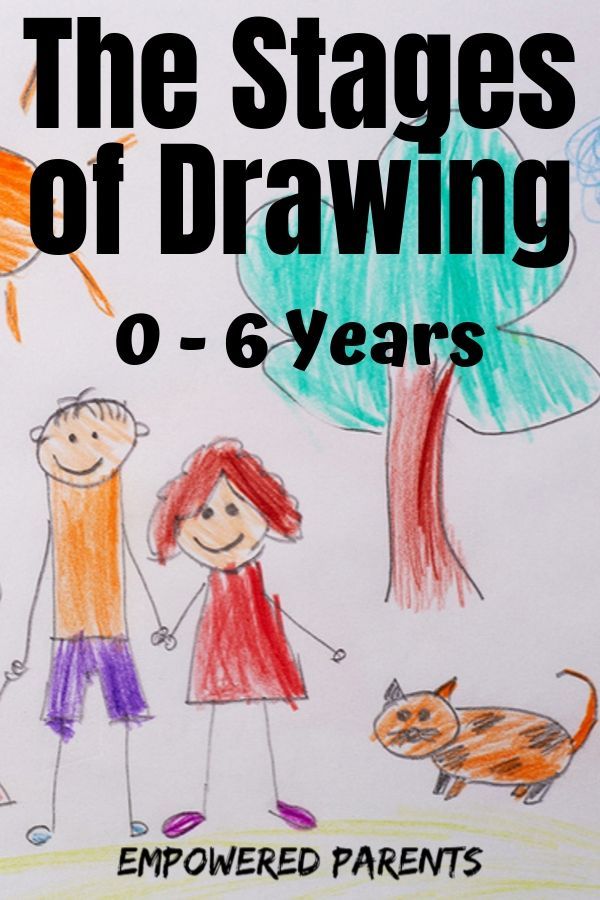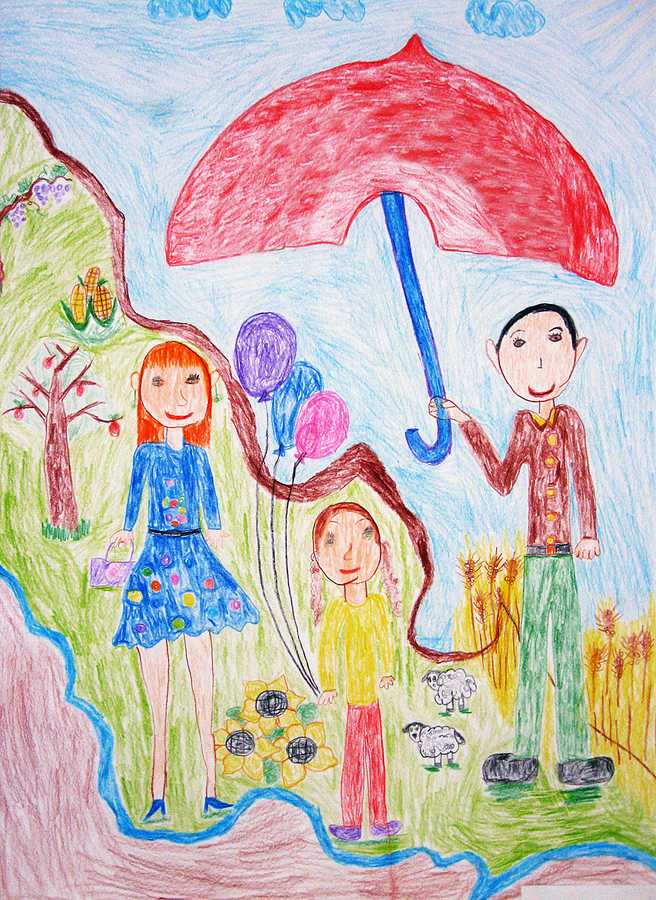Do You Learn to Draw as Circle or a Square

Here is a brief overview of the fascinating stages of drawing in child development and why it's of import to encourage young children to draw.
Drawing is a natural process for all children. From infancy, children begin past experimenting with drawing tools and making marks on paper, and every bit they abound, these marks start taking on meaning.
Drawing ultimately becomes a child's style of expressing their understanding of the world and all the things that are of import to them.
Discover out how children larn to draw and why it's a crucial activeness. There is too a breakdown of the stages of drawing development at various ages.
How to Teach a Child to Draw
During the early years, It's important to focus on the process of creative drawing, and not on the production.
There is no need to formally teach children to describe. The best mode to teach them is to give them exposure to materials and drawing tools and permit them express themselves freely.
As they abound and mature, their drawings will get more than detailed and reflect the earth around them.
Avert the temptation to provide models for children to copy and limit their exposure to colouring books . These only serve to take abroad natural inventiveness.

Why Cartoon is Important
There are many benefits of drawing during the toddler and preschool years. It:
- builds a kid's fine motor skills
- develops paw-eye coordination
- develops creative expression through costless cartoon
- is the foundation of pre-writing skills
- builds a child's attention span
- develops cognitive agreement of concepts
Tracing pictures or "teaching" a kid to draw by following models are non natural, historic period-appropriate ways to develop creativity.
The Stages of Drawing
Here are the characteristics of the various developmental stages of children's drawings. These are not set in rock every bit children develop at their own unique rates.
They will reach the milestones at their ain pace, nevertheless, they all progress through the same stages, which are based on their level of understanding.
The characteristics are listed by age.
Sentinel the video below for a summary of each stage, or read on for a breakdown of the various ages.
12 Months: Random Marks and Scribbles
The first stage of drawing is nearly exploring and developing motor coordination.
At around 15 to 18 months babies begin to develop uncontrolled scribbles that don't represent annihilation.
Shapes
Babies begin past making random marks and soon begin to form:
- scribbles
- vertical and horizontal lines
- multiple line drawings
Understanding
For babies, drawing is actually almost learning cause and issue and their ability to brand things happen.
It has little to practice with creating and representing their globe, and more to practise with enjoying their movements and the effects of them.
Their scribbles enable them to learn about the backdrop of objects, materials and tools such equally pencils, pens, paint, crayons and paper.
Grip
From around 15 months of historic period, toddlers are normally able to grasp crayons with their whole mitt (chosen a palmar grasp).
two Years: Controlled Scribbles
This stage is known every bit controlled scribbling .
Information technology is characterized by spontaneous circular or to-and-fro scribbles and dots.
Similar scribbles tin can be found in all children'due south drawings at this historic period and the shapes in them are necessary for developing cartoon and writing skills afterward.
Shapes
Toddlers begin to make drawings that include:
- horizontal and vertical lines
- multiple loops and spirals
- roughly fatigued circles
- shapes that resemble letters T and Five

Grip
2-twelvemonth-olds larn to hold a pencil well down the shaft towards the betoken, using their pollex and starting time two fingers (called a tripod grasp).
They will commonly use their preferred manus.
Understanding
At this age, toddlers brainstorm to discover the connection between the movements they make and the marks that form on the paper. They will begin to repeat movements on purpose.
By the stop of this twelvemonth, these drawings evolve into simple diagrams .
three Years: Bones Shapes
During this stage, children begin to apply basic shapes in their drawings as their fine motor command and hand-eye coordination improve.
Shapes
Drawings at this historic period include the post-obit shapes, combined in dissimilar means:
- circles and squares
- crosses
- dots
- shapes that resemble letters T, V and H
Drawing of a person
The first cartoon of a person ordinarily emerges around 3 or four years of age.
These 'polliwog' people are drawn with just a head and usually legs direct fastened to the caput.
Grip
A 3-twelvemonth-old holds a pencil near the tip, between the first two fingers and the thumb.
They use the preferred hand and hold the pencil with good control.
At this age, you can help your child develop a practiced tripod grasp by using triangular crayons.
Understanding
At this age, children are able to tell you what their scribbles represent, although you may not exist able to run across what they have described.


They ordinarily name their picture while drawing it or after it is complete, but they do not start a drawing with a clear plan for what they will draw.
The utilise of colour at this stage is unrealistic and they frequently prefer to use merely one color.
iv Years: Patterns and 'Polliwog' People
Past 4 years of age, patterns start emerging in children'southward drawings. A child will make a design and translate it as a representation of something, giving it a label.
Shapes
Their drawings include:
- Squares, circles and rectangles
- Attempts at triangles and diamonds, although she may non be able to class them yet
- Crosses
- Messages (pretend writing)
Cartoon of a person
A four-year-sometime's drawing of a person will progress from a caput with legs to include details such as eyes – since eye contact is important to them.
They depict not what they see, but what they know, and volition add details as they become important to them.
Details such as artillery, fingers and a trunk emerge.
Cartoon other images
By four-and-a-one-half they begin to combine 2 or more than shapes or forms together to form basic images, such as a rectangle and a circle to form a chapeau. They often learn this from adults.
The first shapes children brand consistently will usually form people, simply later includes basic images such as a house or sun.
Grip
At this stage, they hold a pencil with good control, in an developed way.
Understanding
Drawing takes on more meaning and intention. Children normally decide what they are going to draw before they begin.
They deliberately endeavor to combine shapes and lines together and their pictures starting time to wait like the images they describe.
5 Years: Pictures and Portraits
five-year-olds begin to evidence much inventiveness in their drawings.
Shapes
Their drawings will include:
- Bones shapes
- Triangles and diamonds
- Spontaneous letters (to imitate writing)
Drawing of a person
A portrait of a person emerges, with many details such equally hair, hands and fingers, feet and a body.
Drawing other images
They depict images such as animals, houses, vehicles, trees, plants, flowers and rainbows.
They are able to include details – such as drawing a business firm with a door, windows, roof and chimney.

Grip
By 5 years of historic period, children should take adult skilful command when holding a pencil, crayon or paintbrush.
Understanding
Children volition now draw spontaneously and begin to prove their own background, interests and experiences in their drawings. They draw what they know.
Their representation of people, animals and houses changes constantly.
They will likewise proper noun their film earlier get-go.
They can colour within the lines but their use of colour may still be unrealistic.
At this signal, people and objects may still be floating in the air every bit children are still developing spatial perception.
They commonly place themself in the middle of a drawing due to their egocentric nature (seeing themselves as the centre of the world).
six Years: Drawings Represent Interests and Feel
By 6 or 7 years, children have their own style of cartoon, which can unremarkably be recognized by adults.
Shapes
By the time they are 7, they volition be able to form adept circles, squares, rectangles, triangles and diamonds in his drawings.
Cartoon of a person
A kid normally settles on a certain representation of a person at this age and tends to depict them all with the same basic shape.
For example, they will draw the whole family unit with the same body outline but volition brand the members of the family unlike sizes and testify gender with hair and clothes.

Drawing other images
Drawings represent all kinds of animals and things, commonly those that interest them the near.
They tend to draw animals with human being-like faces.
Agreement
At this stage, children show their higher level of noesis by drawing people, animals and objects on a baseline, such equally on the ground or grass.

They also testify perception by drawing, for example, copse higher than the house or flowers that are small.
This drawing shows a child'south greater understanding of depth and distance.

The way they see the world comes through their drawings. They get out out unimportant things and enlarge things that are important to them.
They may draw a small-scale door on a house, just big enough for themselves, or very high windows, since they cannot reach them.
They tin can also show movement in their drawings by portraying objects that are flying or cartoon the legs of an beast wider autonomously if running.
Their use of colour becomes quite realistic.
I hope you've enjoyed reading well-nigh the stages of drawing development in immature children and are inspired to encourage your children to exercise lots of gratis cartoon and artistic expression.
Sources:
Hendrick, H . 1990. Total Learning: Developmental Curriculum for the Young Kid . Third Edition. Macmillan Publishing Company: New York.
Pieterse, M. 2007. Linguistic communication and School Readiness . Metz Press: Welgemoed.
Natanson, J. 1998. Learning Through Play: A parent's guide to the get-go five years. Tafelberg Publishers Limited: Cape Town.
Fisher, B. 1991. Joyful Learning: A Whole Language Kindergarten. Heinemann: New Hampshire.
foxworthdindoutiors.blogspot.com
Source: https://empoweredparents.co/child-development-drawing-stages/
0 Response to "Do You Learn to Draw as Circle or a Square"
Postar um comentário